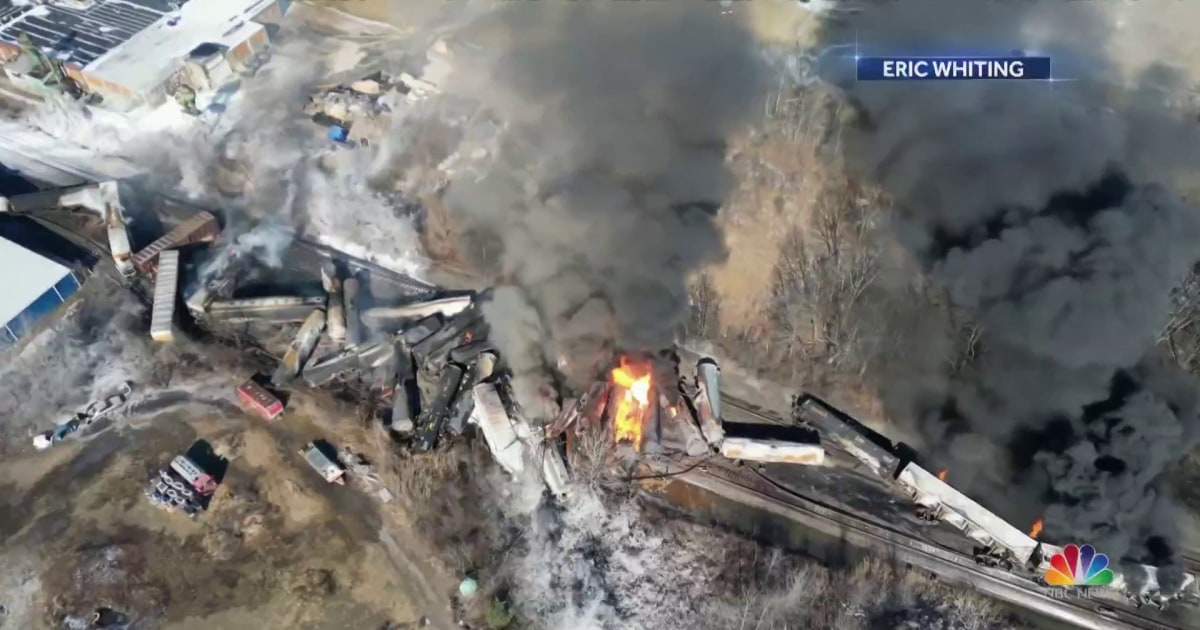Ohio Train Derailment Aftermath: The Lingering Threat Of Toxic Chemicals In Buildings

Table of Contents
Assessing the Extent of Contamination: Identifying Affected Buildings
Identifying buildings affected by the dispersion of toxic chemicals from the derailment presents a formidable challenge. The unpredictable nature of chemical plumes, influenced by wind patterns and environmental factors, makes pinpointing contaminated areas incredibly complex. Accurate assessment requires a multi-pronged approach utilizing various detection and testing methods.
-
Methods for Detection and Testing: Air quality monitoring, employing sophisticated sensors to detect airborne chemicals, is crucial. Soil testing helps determine the extent of ground contamination, which can leach into building foundations. Water sampling analyzes potential contamination of wells and municipal water supplies that may indirectly affect buildings.
-
Types of Buildings Potentially Affected: The potential for chemical contamination extends across various building types, including residential homes, commercial spaces (offices, shops, restaurants), and industrial facilities. Proximity to the derailment site significantly impacts contamination levels.
-
Factors Influencing Contamination Levels: Wind direction during and after the derailment played a crucial role in dispersing the chemical plume. Proximity to the derailment site, building materials (porosity and permeability), and even the orientation of buildings relative to prevailing winds all influence the extent of contamination.
-
Role of Government Agencies and Private Companies: Government agencies like the EPA (Environmental Protection Agency) and state environmental departments play a crucial role in overseeing assessments and setting safety standards. Private environmental consulting firms conduct testing and provide remediation services, offering expertise in chemical analysis and cleanup strategies.
Health Risks Associated with Toxic Chemical Exposure in Buildings
Exposure to the specific chemicals released during the Ohio train derailment, such as vinyl chloride, poses significant health risks. Vinyl chloride is a known carcinogen, and exposure can lead to a range of short-term and long-term health consequences.
-
Short-Term and Long-Term Health Effects: Short-term effects might include respiratory irritation, headaches, dizziness, and nausea. However, long-term exposure to vinyl chloride and other released chemicals carries a heightened risk of serious health problems, including:
- Respiratory problems: Asthma, bronchitis, and other lung diseases.
- Neurological issues: Headaches, cognitive impairment, and peripheral neuropathy.
- Cancer risks: Liver cancer, brain cancer, and leukemia are all potential long-term risks.
- Reproductive health concerns: Infertility and birth defects.
-
Symptoms of Exposure and When to Seek Medical Attention: If you experience any of the symptoms listed above, especially after prolonged exposure to the affected area, it's crucial to seek immediate medical attention. Early diagnosis and treatment can improve outcomes.
Cleaning and Remediation Strategies for Contaminated Buildings
Cleaning and remediation of buildings affected by toxic chemicals is a complex and costly process that depends heavily on the type of building materials and the extent of contamination. Several approaches may be employed depending on the circumstances:
-
Remediation Techniques: Decontamination involves the removal or neutralization of contaminants using specialized cleaning agents and techniques. In cases of severe contamination, demolition and rebuilding may be necessary. Other methods include soil vapor extraction and air scrubbing.
-
Cost Implications of Cleaning and Remediation: The cost of cleaning and remediation can range from thousands to millions of dollars depending on the size of the building, the extent of contamination, and the remediation techniques used.
-
Regulations and Standards Guiding the Process: Strict regulations and standards guide the remediation process to ensure the safety of workers and the public. These regulations are enforced by government agencies and often involve rigorous testing before and after remediation.
-
Challenges in Ensuring Complete Removal of Toxic Chemicals: Completely eliminating all traces of toxic chemicals can be exceedingly challenging due to the complex nature of chemical interactions with building materials and the potential for deep penetration into structures. Long-term monitoring is therefore crucial.
-
The Role of Specialized Contractors and Environmental Agencies: Specialized environmental contractors with experience in handling hazardous materials play a critical role in implementing remediation strategies under the oversight of environmental agencies.
Legal and Regulatory Responses to the Ohio Train Derailment and Building Contamination
The Ohio train derailment has triggered significant legal and regulatory responses, raising critical questions of liability and accountability.
-
Liability and Compensation for Affected Individuals: Legal action is underway to determine the liability of Norfolk Southern Railway and other potentially responsible parties. Affected residents and businesses may seek compensation for medical expenses, property damage, and other losses.
-
Regulatory Oversight and Enforcement: The derailment has highlighted weaknesses in existing regulations regarding hazardous material transportation and emergency response. Strengthening these regulations is a key priority.
-
Potential Legislative Changes to Prevent Future Incidents: The incident has spurred calls for stricter safety regulations, improved emergency response protocols, and increased transparency in the handling of hazardous materials.
Long-Term Monitoring and Public Health Surveillance
The long-term impacts of the Ohio train derailment require ongoing monitoring and public health surveillance.
-
Importance of Continued Air and Water Quality Monitoring: Regular monitoring of air and water quality is crucial to detect any persistent contamination and assess the effectiveness of remediation efforts.
-
Strategies for Long-Term Health Surveillance: Public health agencies need to establish long-term health surveillance programs to track the health outcomes of residents in affected areas. This involves tracking the incidence of specific diseases and conditions potentially linked to chemical exposure.
-
The Need for Transparent Communication and Public Access to Information: Transparency in communication with the public is vital to building trust and ensuring that residents have access to the information they need to protect their health and well-being.
Understanding and Addressing the Lingering Threat of Toxic Chemicals in Buildings After the Ohio Derailment
The Ohio train derailment underscores the devastating and long-lasting consequences of hazardous material accidents, especially the silent danger of toxic chemicals in buildings. Thorough assessment, effective remediation strategies, and ongoing monitoring are crucial to mitigating the long-term risks. Stronger regulations, preventative measures, and increased accountability from responsible parties are essential to prevent future incidents and protect communities from the lingering threat of building contamination. If you suspect building contamination from the Ohio train derailment, seek professional help immediately to assess the risk and take necessary steps to protect your health and property. Stay informed, participate in community discussions, and demand accountability to address the lasting threat of toxic chemicals in buildings.

Featured Posts
-
 Accor Reports Increased Canadian Tourism Amid Us Travel Decline
Apr 27, 2025
Accor Reports Increased Canadian Tourism Amid Us Travel Decline
Apr 27, 2025 -
 Despedida Temprana Para Paolini Y Pegula En El Wta 1000 De Dubai
Apr 27, 2025
Despedida Temprana Para Paolini Y Pegula En El Wta 1000 De Dubai
Apr 27, 2025 -
 Cerundolo Avanza A Cuartos De Final De Indian Wells Tras Bajas De Fritz Y Gauff
Apr 27, 2025
Cerundolo Avanza A Cuartos De Final De Indian Wells Tras Bajas De Fritz Y Gauff
Apr 27, 2025 -
 Alejandro Tabilo Upsets Novak Djokovic In Straight Sets At Monte Carlo Masters 2025
Apr 27, 2025
Alejandro Tabilo Upsets Novak Djokovic In Straight Sets At Monte Carlo Masters 2025
Apr 27, 2025 -
 Controversial Choice Vaccine Skeptic To Lead Federal Immunization Autism Research
Apr 27, 2025
Controversial Choice Vaccine Skeptic To Lead Federal Immunization Autism Research
Apr 27, 2025
Latest Posts
-
 Crumbachs Departure Analyzing The Future Of The Bsw And The Spd Coalition
Apr 27, 2025
Crumbachs Departure Analyzing The Future Of The Bsw And The Spd Coalition
Apr 27, 2025 -
 German Coalition Stability After Bsw Leaders Resignation
Apr 27, 2025
German Coalition Stability After Bsw Leaders Resignation
Apr 27, 2025 -
 Crumbach Steps Down Impact On Bsw And The German Coalition
Apr 27, 2025
Crumbach Steps Down Impact On Bsw And The German Coalition
Apr 27, 2025 -
 Bsw Leader Crumbachs Resignation Spd Confirms Coalition Remains Stable
Apr 27, 2025
Bsw Leader Crumbachs Resignation Spd Confirms Coalition Remains Stable
Apr 27, 2025 -
 Concerns Raised Over Hhss Appointment Of Anti Vaccine Activist To Investigate Autism Vaccine Claims
Apr 27, 2025
Concerns Raised Over Hhss Appointment Of Anti Vaccine Activist To Investigate Autism Vaccine Claims
Apr 27, 2025
